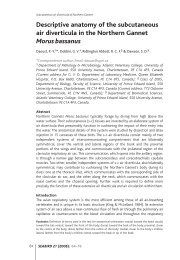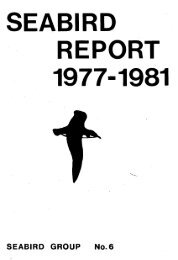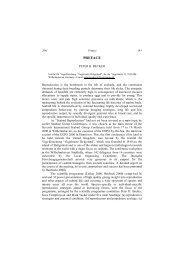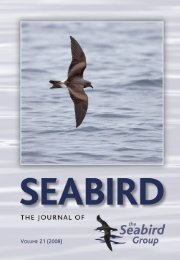Vol 6 No. 2 - The Seabird Group
Vol 6 No. 2 - The Seabird Group
Vol 6 No. 2 - The Seabird Group
Create successful ePaper yourself
Turn your PDF publications into a flip-book with our unique Google optimized e-Paper software.
2004 Diet of Mediterranean Gull 73<br />
Table 4. Continued. Tabel 4 vervolg.<br />
Animals 04.08 15.08. 24.08 04.09 Total<br />
eomys annomalus 0 1 0 0 1<br />
Crocidura suaveolens 1 1 0 0 2<br />
C.leucodon 1 0 0 0 1<br />
Mus musculus/spretus 8 4 4 1 17<br />
Rattus sp. juv. 2 0 1 0 3<br />
Microtus arvalis/rossiaemeridionalis 12 11 4 1 28<br />
Subtotal Mammalia 24 17 9 2 52<br />
(average per pellet) (1.3) (1.5) (1.2) (1) (1.3) 4%<br />
Subtotal Vertebrata 95 84 50 9 238<br />
(average per pellet) (1.1) (1.2) (1.1) (1) (1.1)16%<br />
Total All Animals 573 524 324 43 1464<br />
<strong>No</strong>te: <strong>The</strong> total number of individuals in the intact and disintegrated pellets excludes here one pellet<br />
with two tortoise Testudo sp. eggs from the first collection and the eggs of Thomas's Rapa Whelk<br />
Rapana thomasiana in the disintegrated pellets from the second collection.<br />
Pipefish Syngnathus acus. <strong>No</strong> significant differences were found in the pellets<br />
containing invertebrates and the three groups of vertebrates, or in their amounts<br />
in the diet. Highly significant differences were apparent in the catch of the seven<br />
groups of invertebrates (χ²18 = 108.1, Р< 0.001). Carabid beetles occurred in<br />
significantly greater numbers on the last collection date in contrast to the lower<br />
numbers in the first collection date. Crustaceans occurred in greater numbers on<br />
the second collection date, in in contrast to the first date. Among the “other”<br />
insects, significantly greater numbers were found in the third collection (47<br />
individuals of ants) and lesser numbers in the second.<br />
DISCUSSION<br />
<strong>The</strong> seeds of three crop plants, Barley, Wheat and Sunflower, plus Ragwort<br />
constituted the main diet of the Mediterranean Gulls during this study. Ragwort<br />
was mostly mixed in with pellets containing barley and wheat seeds, as Ragwort<br />
grew in the fields under these crops. Seeds of crop plants have been found in<br />
gull diets during their breeding period as well, but were not a staple in the diet<br />
(Ardamatskaya et al. 1988, Goutner 1986, 1994, Meininger et al. 1991).<br />
Predominance of seeds in the gull diet reported here does not correspond to<br />
previous accounts of Mediterranean gull diets after nesting is completed, citing<br />
chiefly marine fishes and molluscs (Burger & Gochfeld 1996, Snow & Perrins<br />
1998).








